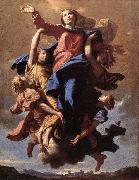
|
Nicolas Poussin
|
|||
|
|
|||
| French 1594-1665 Nicolas Poussin Galleries The finest collection of Poussin's paintings, in addition to his drawings, is located in the Louvre in Paris. Besides the pictures in the National Gallery and at Dulwich, England possesses several of his most considerable works: The Triumph of Pan is at Basildon House, near to Pangbourne, (Berkshire), and his great allegorical painting of the Arts at Knowsley. The later version of Tancred and Erminia is at the Barber Institute in Birmingham. At Rome, in the Colonna and Valentini Palaces, are notable works by him, and one of the private apartments of Prince Doria is decorated by a great series of landscapes in distemper. Throughout his life he stood aloof from the popular movement of his native school. French art in his day was purely decorative, but in Poussin we find a survival of the impulses of the Renaissance coupled with conscious reference to classic work as the standard of excellence. In general we see his paintings at a great disadvantage: for the color, even of the best preserved, has changed in parts, so that the harmony is disturbed; and the noble construction of his designs can be better seen in engravings than in the original. Among the many who have reproduced his works, Audran, Claudine Stella, Picart and Pesne are the most successful. | |||
|
|
|||
|
The Assumption of the Virgin Nicolas Poussin68.jpg Painting ID:: 10124 |
1650 Oil on canvas 57 x 40 cmLouvre | ||
|
|
|||
|
PIAZZETTA, Giovanni Battista
|
|||
|
|
|||
| Italian Rococo Era Painter, ca.1683-1754 | |||
|
|
|||
|
The Assumption of the Virgin new5/PIAZZETTA, Giovanni Battista-282684.jpg Painting ID:: 19870 |
1735 Oil on canvas Mus??e du Louvre, Paris. | ||
|
|
|||
|
Annibale Carracci
|
|||
|
|
|||
| 1560-1609 Italian Annibale Carracci Locations Painter, draughtsman and printmaker, brother of (2) Agostino Carracci. Since his lifetime, he has been considered one of the greatest Italian painters of his age. His masterpiece, the ceiling (1597-1601) of the Galleria Farnese, Rome, merges a vibrant naturalism with the formal language of classicism in a grand and monumental style. Annibale was also instrumental in evolving the ideal, classical landscape and is generally credited with the invention of CARICATURE. | |||
|
|
|||
|
The Assumption of the Virgin new3/Annibale Carracci-285495.jpg Painting ID:: 28089 |
mk61 c.1590 Oil on canvas 130x97cm | ||
|
|
|||
|
Bartolome Esteban Murillo
|
|||
|
|
|||
| Spanish 1618-1682 Bartolome Esteban Murillo Galleries Murillo began his art studies under Juan del Castillo in Seville. Murillo became familiar with Flemish painting; the great commercial importance of Seville at the time ensured that he was also subject to influences from other regions. His first works were influenced by Zurbaran, Jusepe de Ribera and Alonso Cano, and he shared their strongly realist approach. As his painting developed, his more important works evolved towards the polished style that suited the bourgeois and aristocratic tastes of the time, demonstrated especially in his Roman Catholic religious works. In 1642, at the age of 26 he moved to Madrid, where he most likely became familiar with the work of Velazquez, and would have seen the work of Venetian and Flemish masters in the royal collections; the rich colors and softly modeled forms of his subsequent work suggest these influences. He returned to Seville in 1645. In that year, he painted thirteen canvases for the monastery of St. Francisco el Grande in Seville which gave his reputation a well-deserved boost. Following the completion of a pair of pictures for the Seville Cathedral, he began to specialise in the themes that brought him his greatest successes, the Virgin and Child, and the Immaculate Conception. After another period in Madrid, from 1658 to 1660, he returned to Seville. Here he was one of the founders of the Academia de Bellas Artes (Academy of Art), sharing its direction, in 1660, with the architect, Francisco Herrera the Younger. This was his period of greatest activity, and he received numerous important commissions, among them the altarpieces for the Augustinian monastery, the paintings for Santa Mar??a la Blanca (completed in 1665), and others. | |||
|
|
|||
|
The Assumption of the Virgin new3/Bartolome Esteban Murillo-372959.jpg Painting ID:: 29187 |
mk65 1670s Oil on canvas 77x57" | ||
|
|
|||
|
Matteo Di Giovanni
|
|||
|
|
|||
| Italian Early Renaissance Painter, ca.1430-1495 | |||
|
|
|||
|
The Assumption of the Virgin new16/Matteo Di Giovanni-297277.jpg Painting ID:: 42864 |
mk170 circa 1474 Tempera on wood 331.5x174cm | ||
|
|
|||
|
Also Buy::. For Following Paintings / Artists / Products, Please Use Our Search Online: |












